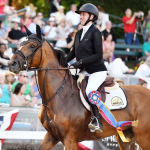Keeping horses active during the winter is crucial for their physical and mental well-being. Exercise helps keep horses healthy, which can reduce the risk of muscle and joint problems. Daily leg stretches, walks, or groundwork sessions in a dry outdoor area or in an indoor area can help keep your horses active during the winter season.
While managing your horses this winter keep in mind the basics. We will discuss each of these basic needs more thoroughly: a dry and well ventilated shelter/ barn with appropriate stall bedding, blanketing horses, access to fresh water during freezing temperatures, and hay and nutrition. By managing these needs horses will maintain good health and will be ready for the warmer spring months ahead.
As the days grow shorter, temperatures drop, and the landscape turns cold and bare, many individuals experience a phenomenon known as the “winter blues.” This seasonal slump can affect various aspects of life, including equestrian activities. Delving into the winter blues and its impact on equestrians, arms us with knowledge to mitigate the effect winter has on us, as well as arming us with the knowledge to know what to do when we are affected. We will explore the causes, symptoms, and strategies to treat and overcome this seasonal challenge.
The winter blues, also referred to as Seasonal Affective Disorder (SAD), is a subtype of depression that occurs in certain seasons, typically during fall and winter. The exact cause of SAD is unknown, but it is believed to be linked to reduced sunlight exposure and changes in melatonin and serotonin levels in the brain. Equestrians are not exempt from this condition and may experience a decline in mood, motivation, and overall well-being during the winter months. Like other athletes that thrive during the warmer months, equestrians usually have a lull in equine related physical activity and competition levels during winter.
The winter blues can significantly impact equestrians, affecting their motivation, energy levels, and enjoyment of riding and horse care. Cold weather, limited daylight, and challenging footing conditions can make it difficult to engage in regular riding sessions and maintain a consistent training routine. Additionally, the lack of sunlight and reduced outdoor time can lead to vitamin D deficiency, further exacerbating the winter blues.
One of the most effective treatments for SAD is light therapy. The best way to accomplish this, if the temperatures are more on the mild side, is getting fresh air out in the sunshine. Unfortunately, that is not always possible. In the event that the temperatures are more on the harsh side, the use of light boxes can be employed. Light boxes that emit bright, artificial light can help simulate sunlight and regulate the body’s internal clock. Equestrians can incorporate light therapy by spending time near a light box or using portable light devices while grooming, tacking up, or even during indoor riding sessions. It is recommended to expose oneself to bright light for 30 minutes to an hour each day, preferably in the morning.
Engaging in regular physical exercise has been proven to boost mood and alleviate symptoms of depression. Equestrians can combat the winter blues by incorporating outdoor activities and exercise into their routine. Riding, lunging, or even hand-walking their horses can provide both physical and mental stimulation, which not only will benefit the equestrian, but also benefit their horse. If outdoor riding is not possible due to unfavorable weather conditions, equestrians can consider using indoor arenas or participating in other activities such as yoga or fitness classes.
Vitamin D deficiency is common during the winter months when sunlight exposure is limited. Equestrians can consult with their healthcare provider to determine if vitamin D supplementation is necessary. Adequate levels of vitamin D are crucial for maintaining overall health and well-being, and supplementation may help alleviate symptoms of the winter blues.
Practicing mindfulness and stress reduction techniques can be beneficial in combating the winter blues. Equestrians can incorporate activities such as meditation, deep breathing exercises, or yoga into their daily routine. These practices help reduce stress, increase self-awareness, and promote mental well-being. When you are trapped inside due to the inclement conditions outdoors, it is a good time to commit to focusing on creating a stronger body, by incorporating an exercise and stretching routine into your schedule.
Maintaining social connections and seeking support from fellow equestrians can be invaluable in navigating the winter blues. Engaging in group rides, attending equestrian events, or joining online communities can provide a sense of belonging and support. Sharing experiences, challenges, and strategies with others who understand the equestrian lifestyle can help alleviate feelings of isolation and boost mood. This can be accomplished by simply getting together with a friend and grooming your horses.
Setting realistic goals and focusing on positive reinforcement can help equestrians stay motivated and maintain a sense of accomplishment during the winter months. Breaking down large goals into smaller, manageable tasks and rewarding oneself for progress can provide a sense of purpose and fulfillment. Utilizing the time away from riding activities to work on mentally or physically preparing yourself to be more in shape, flexible, and stronger for the following season.
If the winter blues persist and significantly impact daily life and equestrian activities, it is essential to seek professional help. Consulting with a healthcare provider, therapist, or counselor can provide additional guidance and support. They can evaluate the severity of the symptoms, provide appropriate treatment options, and help develop coping strategies specific to individual needs.
Seasonal Affective Disorder can pose significant challenges for equestrians, affecting their mood, motivation, and overall enjoyment of riding and horse care. However, by understanding the causes and symptoms of the winter blues and implementing effective treatment strategies, equestrians can overcome this seasonal slump. Incorporating light therapy, engaging in regular exercise, ensuring adequate vitamin D levels, practicing mindfulness, seeking social support, setting goals, and seeking professional help when needed are all crucial steps in treating and managing the winter blues. By taking proactive measures, equestrians can maintain their passion for riding and ensure their well-being during the colder months.









